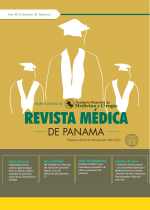Características Clínicas Y Quirurgicas De Pacientes Sometidos A Cirugía De Válvula Mitral En Una Institucion De Salud De Barranquilla (Colombia)
Autores/as
DOI:
https://doi.org/10.37980/im.journal.rmdp.2019793Resumen
[Clinical and surgical characteristics of patients undergoing mitral valve surgery at a health institution in Barranquilla, Colombia]
Resumen
Introducción: la incidencia de las anomalías valvulares cardiacas ha aumentado entre otras razones por los avances en métodos diagnósticos y conocimiento de predecesores etiológicos como desencadenantes de la condición clínica, que inicia la probabilidad diagnostica y seguimiento temprano en pacientes en estadios iniciales de la enfermedad, disminuyendo de esta manera el impacto económico por aumento de la morbimortalidad. Objetivo: describir las características clínicas y quirúrgicas de pacientes sometidos a cirugía de válvula mitral en una institución prestadora de servicios de salud de referencia para el distrito de Barranquilla, Colombia, durante los años 2014 a 2016. Metodología: estudio descriptivo, en el que se revisó de forma retrospectiva las historias clínicas de pacientes con patología mitral que requirieron intervención quirúrgica de tipo plastia, cambio biológico o mecánico, entre los años 2014 y 2016. El análisis de la información se realizó a través del software SPSS. Resultados: durante el periodo de estudio se realizaron 276 cirugías valvulares en la institución de salud objeto de estudio, de las cuales 98 fueron cirugías sobre válvula mitral, excluyéndose 20 historias clínicas que no contenían la totalidad de las variables analizadas. El antecedente clínico más frecuente fue la enfermedad coronaria (38,5%), seguido del infarto de miocardio (23,1%); el 20,5% de los pacientes presentaron arritmia tipo fibrilación auricular y la cirugía sobre válvula mitral más realizada fue recambio biológico (42%). Conclusión: las características clínicas y quirúrgicas de los pacientes incluidos en el estudio, son similares a las descritas en la literatura nacional e internacional, por lo que podría tomarse como precedente de presentación y de esta manera ir construyendo una clínica para la identificación rápida y veraz de los pacientes con alteraciones valvulares, permitiendo su abordaje temprano y disminuyendo la carga económica para el sistema de salud.
Abstract
Introduction: cardiac valvular anomalies have increased their presentation, in part due to advances in diagnostic methods and knowledge of etiological predecessors as triggers of the clinical condition that initiates the diagnostic probability and early follow-up in patients in the initial stages of the disease, thus decreasing the economic impact due to increased morbidity and mortality. Objective: to describe the clinical and surgical characteristics of patients undergoing mitral valve surgery at a reference center in the district of Barranquilla during the years 2014 to 2016.Methodology: descriptive, retrospective, cross-sectional study in a health institution in the district of Barranquilla. Patients with mitral pathology who required surgical intervention of the plasty type, biological or mechanical change, were included between 2014 and 2016. Data analysis performed in SPSS according to the nature of the variables. Results: during the study period, 276 valve surgeries were performed, of which 98 were valve surgeries, 20 patients were excluded due to incomplete clinical history; the most prevalent antecedent was coronary disease in 38.5% followed by myocardial infarction with 23.1%; 20.5% of the patients presented arrhythmia type atrial fibrillation; the most performed mitral valve surgery was a 42% biological replacement. Conclusion: the clinical and surgical characteristics of the patients included in the study, correspond to those described in national and international literature, so it could be taken as a precedent for presentation and thus build a presentation clinic for quick and accurate identification of the patients with valvular alterations, allowing their early approach and decreasing the economic burden for the health system.
Publicado
Número
Sección
Licencia
Derechos autoriales y de reproducibilidad. La Revista Médica de Panama es un ente académico, sin fines de lucro, que forma parte de la Academia Panameña de Medicina y Cirugía. Sus publicaciones son de tipo acceso gratuito de su contenido para uso individual y académico, sin restricción. Los derechos autoriales de cada artículo son retenidos por sus autores. Al Publicar en la Revista, el autor otorga Licencia permanente, exclusiva, e irrevocable a la Sociedad para la edición del manuscrito, y otorga a la empresa editorial, Infomedic International Licencia de uso de distribución, indexación y comercial exclusiva, permanente e irrevocable de su contenido y para la generación de productos y servicios derivados del mismo. En caso que el autor obtenga la licencia CC BY, el artículo y sus derivados son de libre acceso y distribución.






